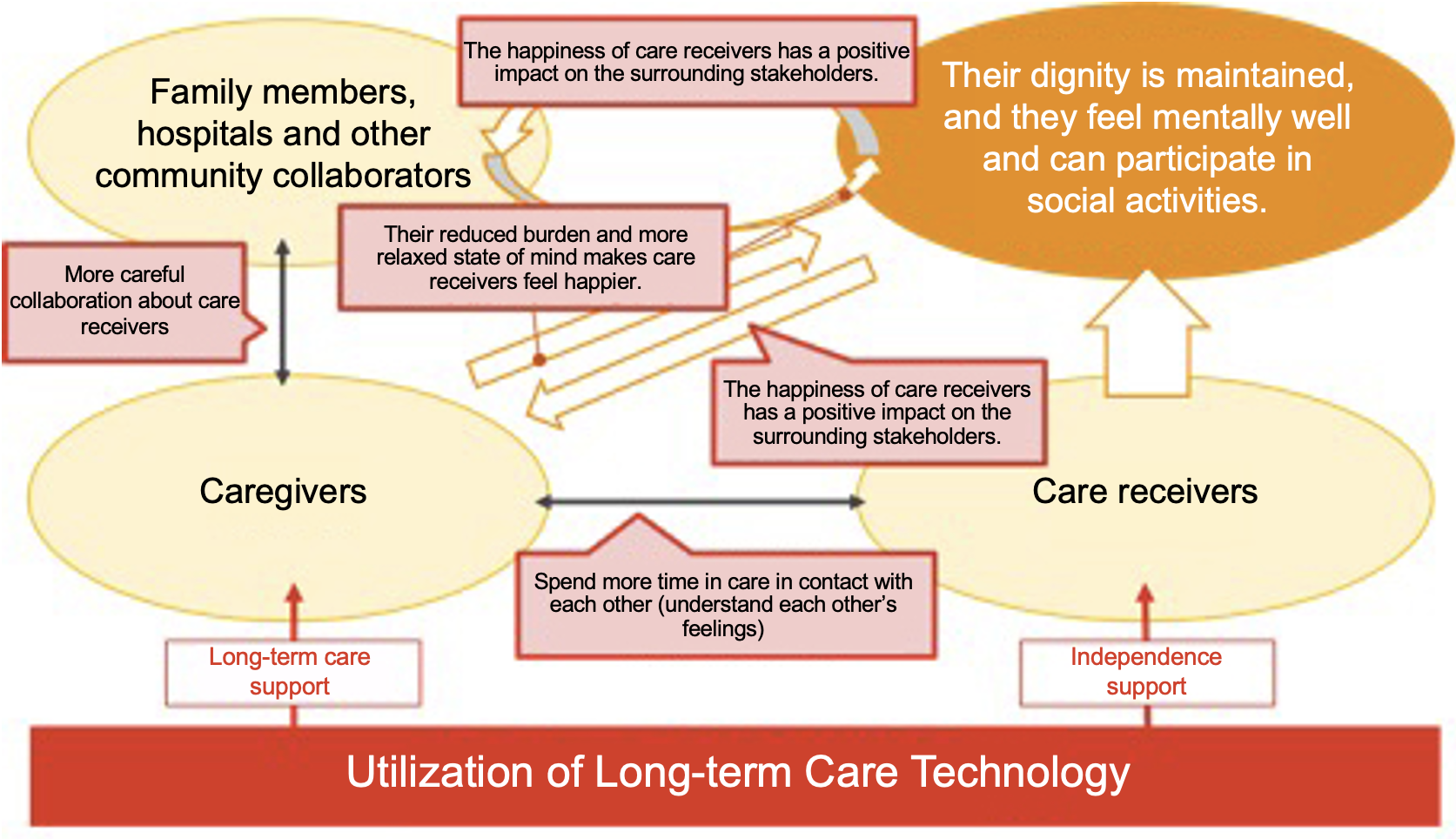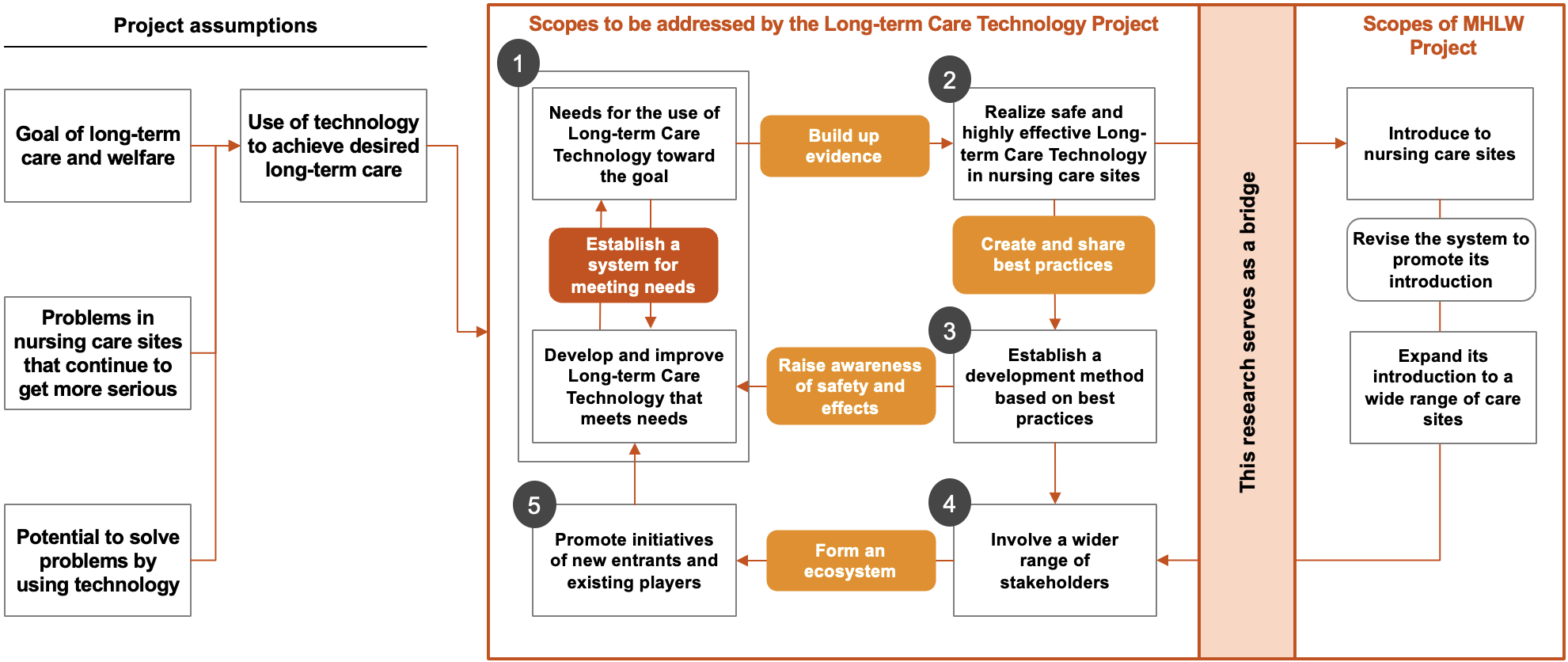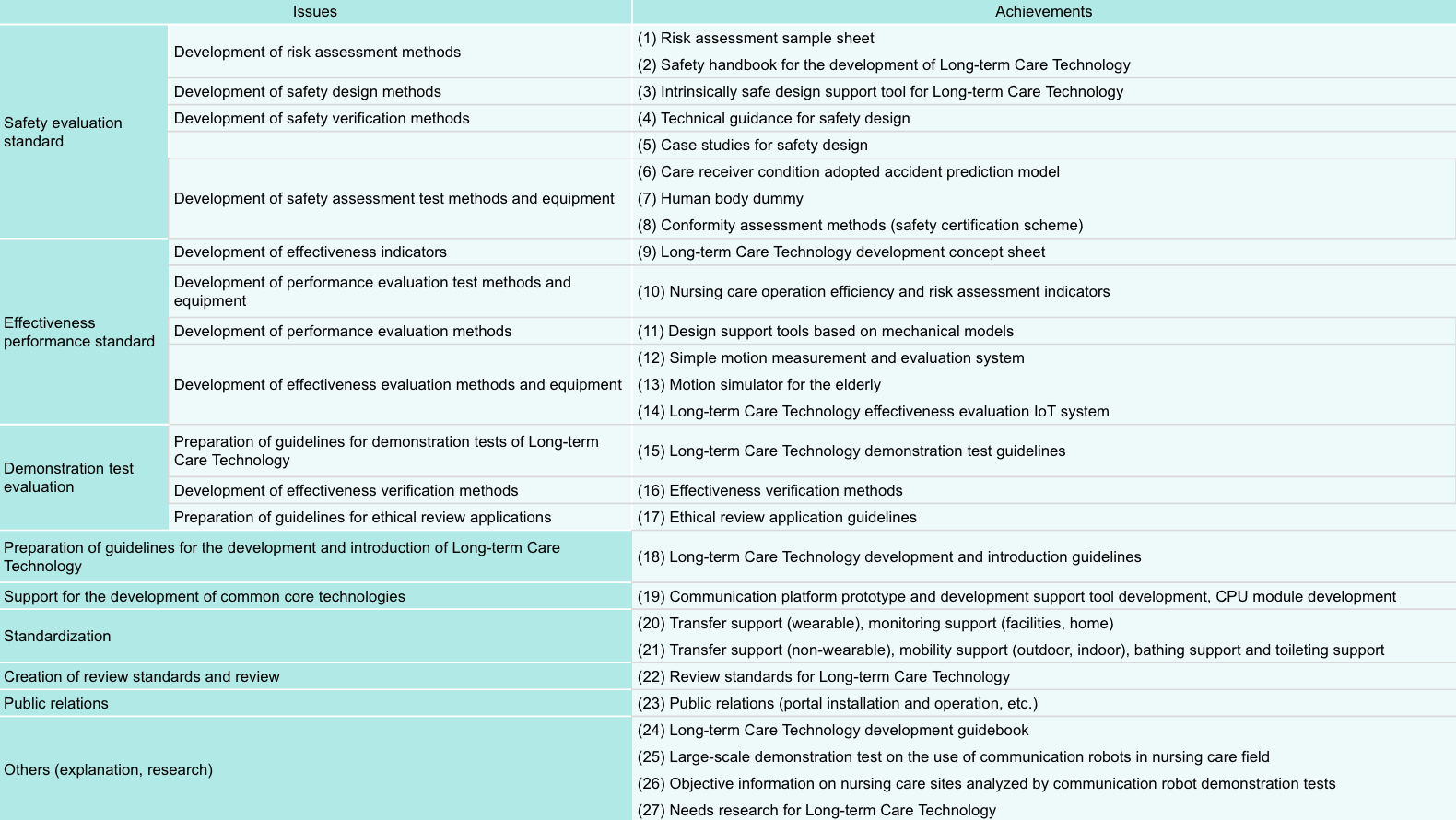Achievements and future prospects of the Long-term Care Technology-related projects
In recent years, the shortage of caregivers in the nursing care industry has long been a concern due to the aging of society and the declining birthrate. In addition, the way nursing care is provided has been reviewed recently. It has shifted from not only simply taking care of the elderly or care receivers by caregivers, but also to supporting their long-term independence and enabling them to do things as much or as long as possible on their own, and valuing their wishes and dignity. At the same time, by supporting caregivers and care by family members, respect for well-being of both caregivers and care receivers to be happy mentally and physically is also becoming more important.
As shown in Figure 1, the use of Long-term Care Technology can support caregivers’ provision of nursing care and care receivers’ independence, ultimately leading to their better physical and mental health, as well as their improved motivation to participate in social activities. (Refer to “Priority fields” for more information on the types of Long-term Care Technology.)
Figure 1. The aim of utilizing Long-term Care Technology

Source: PwC Consulting LLC “Survey Report on the Achievements and Issues of Long-term Care Technology Projects and the Expansion of Long-term Care and Welfare Equipment Projects (conducted in FY2020),” commissioned by the Japan Agency for Medical Research and Development (AMED) *Partially modified.
What is the purpose of the Long-term Care Technology Project?
The Long-term Care Technology Project was launched by the Ministry of Economy, Trade and Industry in FY2013. Its purpose is to create a new market for Long-term Care Technology by supporting the development and introduction of Long-term Care Technology in the “Priority Fields in the Use of Robot Technology for Long-term Care” and supporting the independence of care receivers and reducing the burden on caregivers. One of the reasons for this is that while there are strong expectations for the use of robot technology in nursing care sites from the perspective of reducing the burden on caregivers, the development and commercialization of the Long-term Care Technology field has not progressed as expected due to the following three issues.
- Marketability is not visible.
- Special considerations are required for its development.
- It is difficult for developers to hear the voices of users.
To solve these issues, the Ministry of Economy, Trade and Industry launched this project based on the following three concepts.
(1) Identify the priority fields (refer to the next page) based on the needs at sites (needs-oriented)
(2) Improve usability and accelerate cost reductions with a stage-gate system [1] (low cost)
(3) Provide public support and system allowances to introduce technology to sites (in large amount) [2]
The premise of this project is to achieve the goals of care and welfare by developing and introducing technology based on needs by the project and by using technology to solve problems at nursing care sites that continue to become more serious. To accelerate the launch of the Long-term Care Technology industry, it is considered essential to ascertain the current issues and then set the scopes to be addressed in the future, as shown in Figure 2. To that end, it is expected that Long-term Care Technology will achieve each of the scopes to be addressed through this project. In developing the Long-term Care Technology industry, it will be possible to promote the development and improvement of technology that meets the needs of nursing care facilities by educating developers on the concept of safety and effectiveness. By building up best practices along with evidence, we believe that Long-term Care Technology will contribute to a wide range of nursing care settings and will form an industry.
Figure 2. Scopes to be addressed by the Long-term Care Technology Project

Source: PwC Consulting LLC “Survey Report on the Achievements and Issues of Long-term Care Technology Projects and the Expansion of Long-term Care and Welfare Equipment Projects (conducted in FY2020),” commissioned by the Japan Agency for Medical Research and Development
In the first place, why are the Ministry of Economy, Trade and Industry and AMED taking initiatives based on the concept of “Long-term Care Technology” rather than care robots? This is because there is the idea in the background that “technology not robots is the main focus, and that technology is becoming robotic.” Long-term Care Technology is not regarded as a robot that universally provides care by itself, but rather as a technology that facilitates more effective care by enabling users to operate it and to master using it. Therefore, the term “Long-term Care Technology” is used based on the concept of developing it also from the point of view of users as well. When the project was first launched, the goal was to achieve better care by integrating robots effectively with human care, and this goal remains unchanged to this day.
Past projects and achievements
The Long-term Care Technology Project has been in operation in various forms for almost 10 years. The Ministry of Economy, Trade and Industry started the “Project to Promote the Development and Introduction of Robotic Devices for Nursing Care” in FY2013. Associated with the establishment of AMED in FY2015, the project was transferred to AMED and was implemented until FY2017. The METI project focused on the “Program to Establish/Standardize Criteria” and the “Subsidized Project for Development”.
Then, from FY2018 to FY2020, the Japan Agency for Medical Research and Development (AMED) continued it as the “Project to Promote the Development and Standardization of Robotic Devices for Nursing Care”. The AMED project focused on the “Program to Measure/Evaluate Effects”, “Program to Establish/Standardize Criteria,” and “The Subsidized Project for Development”.
Figure 3. Promoting the development and introduction of Long-term Care Technology

Source: Japan Agency for Medical Research and Development “Promoting the Development and Introduction of Long-term Care Technology” (https://www.amed.go.jp/content/000059153.pdf)
The “Project to Promote the Development of Robotic Devices for Nursing Care” was launched in FY2021, and it consists of two major elements of “Development assistance” and “Environmental improvements”. Its breakdown is as follows.
1. “Project to Promote the Development of Robotic Devices for Nursing Care (Development assistance)”
1-A. Long-term Care Technology development support [Development assistance]
2. “Project to Promote the Development of Robotic Devices for Nursing Care (Development assistance)”
2-A. Quantitative safety standard establishment study [Establishment of safety standard guidelines]
2-B. Environmental improvements, including establishment of clinical evaluation guidance for overseas expansion [Establishment of clinical evaluation guidance for overseas expansion]
2-C. Dissemination of created achievements [Dissemination of development achievements]
The project since FY2021 has been utilizing the achievements of previous projects and accelerating development, including by addressing issues at nursing care sites and at home that have not yet been resolved, and responding to changes at care sites due to the impact of COVID-19, as well as accelerating the expansion of existing products and overseas expansion.
1-A. [Development assistance] supports the “development of technologies and systems of 13 items in 6 priority fields,” including sites that support the elderly themselves to live independently, such as home care, and the “development of technologies and systems that contribute to the prevention of infections at nursing care sites”, targeting sites that tend to be closely packed together, such as nursing care prevention measures taken in a group.
In 2-A. [Establishment of safety standard guidelines], the members will work to provide examples of quantitative standards using more specific products as examples, as risk assessment methods and design/test standards for developing safe technologies have been developed and summarized in the previous projects.
In 2-B. [Establishment of clinical evaluation guidance for overseas expansion], the members will establish clinical evaluation guidance for companies expanding overseas and clinical evaluation guidance for companies expanding in Japan.
In 2-C. [Dissemination of development achievements], the members will promote the use of existing guidance and manuals, create best practices for the introduction of developed technologies, and promote the dissemination of the development and introduction of Long-term Care Technology through the formation of a community.
It is expected that the above four initiatives will work in harmony to create a better way of providing nursing care using the Long-term Care Technology developed in Japan.
Figure 4. List of achievements of the Program to Establish/Standardize Criteria (27 achievements)

“Project to Promote the Development and Introduction of Robotic Devices for Nursing Care” Outline of R&D Project (evaluation at the end of the project), dated June 12, 2020, Robotics Policy Office, Industrial Machinery Division, Manufacturing Industries Bureau, METI
https://www.meti.go.jp/shingikai/sankoshin/sangyo_gijutsu/kenkyu_innovation/hyoka_wg/pdf/053_h06_00.pdf
In addition, 112 technologies were selected for the Subsidized Project for Development from FY2013 to FY2020, and 28 of these had been put into practical applications by the end of FY2020.
Figure 5. Overview of the “Subsidized Project for Development” of the Project to Promote the Development and Standardization of Robotic Devices for Nursing Care

*Selection year of one derivative product is unknown.
Source: PwC Consulting LLC “Survey Report on the Achievements and Issues of Long-term Care Technology Projects and the Expansion of Long-term Care and Welfare Equipment Projects (conducted in FY2020),” commissioned by the Japan Agency for Medical Research and Development
Future initiatives
The “Project to Promote the Development of Robotic Devices for Nursing Care” was launched in FY2021, and it consists of two major elements of “Development assistance” and “Environmental improvements”. Its breakdown is as follows.
1. “Project to Promote the Development of Robotic Devices for Nursing Care (Development assistance)”
1-A. Long-term Care Technology development support [Development assistance]
2. “Project to Promote the Development of Robotic Devices for Nursing Care (Development assistance)”
2-A. Quantitative safety standard establishment study [Establishment of safety standard guidelines]
2-B. Environmental improvements, including establishment of clinical evaluation guidance for overseas expansion [Establishment of clinical evaluation guidance for overseas expansion]
2-C. Dissemination of created achievements [Dissemination of development achievements]
The project since FY2021 has been utilizing the achievements of previous projects and accelerating development, including by addressing issues at nursing care sites and at home that have not yet been resolved, and responding to changes at care sites due to the impact of COVID-19, as well as accelerating the expansion of existing products and overseas expansion.
1-A. [Development assistance] supports the “development of technologies and systems of 13 items in 6 priority fields,” including sites that support the elderly themselves to live independently, such as home care, and the “development of technologies and systems that contribute to the prevention of infections at nursing care sites,” targeting sites that tend to be closely packed together, such as nursing care prevention measures taken in a group.
In 2-A. [Establishment of safety standard guidelines], the members will work to provide examples of quantitative standards using more specific products as examples, as risk assessment methods and design/test standards for developing safe technologies have been developed and summarized in the previous projects.
In 2-B. [Establishment of clinical evaluation guidance for overseas expansion], the members will establish clinical evaluation guidance for companies expanding overseas and clinical evaluation guidance for companies expanding in Japan.
In 2-C. [Dissemination of development achievements], the members will promote the use of existing guidance and manuals, create best practices for the introduction of developed technologies, and promote the dissemination of the development and introduction of Long-term Care Technology through the formation of a community.
It is expected that the above four initiatives will work in harmony to create a better way of providing nursing care using the Long-term Care Technology developed in Japan.
Conclusion
Resolving issues related to nursing care will be the key for Japanese society to address its aging society with a declining birthrate. Long-term Care Technology can support the independence of the elderly, maintain the dignity of care receivers, assist caregivers and family members, and solve the problem of the shortage of human resources at care sites. For these purposes, we need to promote and educate as many people as possible about Long-term Care Technology and the way of using it correctly and usefully so that we can improve the technology even further. It is also expected that in the future, Long-term Care Technology that provides further support for home care will be developed, and that better ways of providing care through system collaborations with various technologies will be considered and achieved.
[1] The stage-gate system was adopted in the initial project but was discontinued in the middle of the project.
[2] “Project to Promote the Development and Introduction of Robotic Devices for Nursing Care” Outline of R&D Project (evaluation at the end of the project), dated June 12, 2020, Robotics Policy Office, Industrial Machinery Division, Manufacturing Industries Bureau, METI